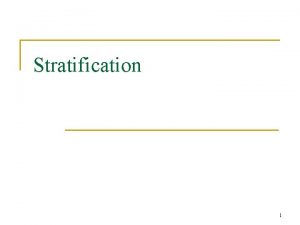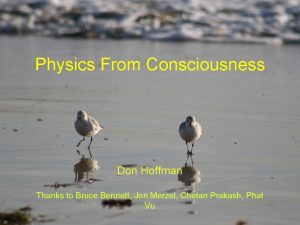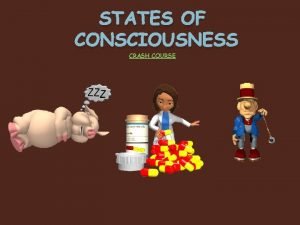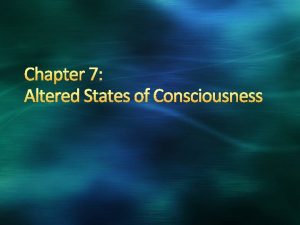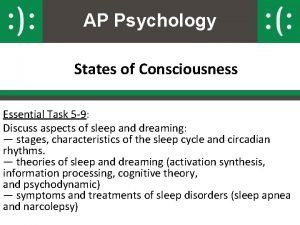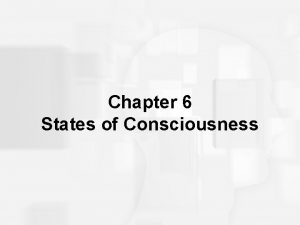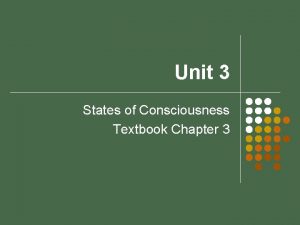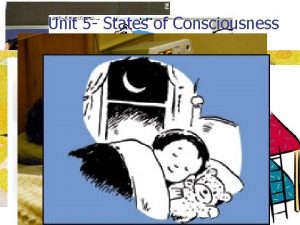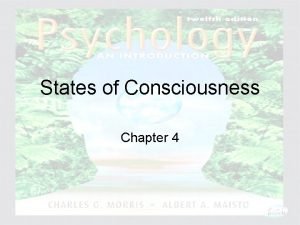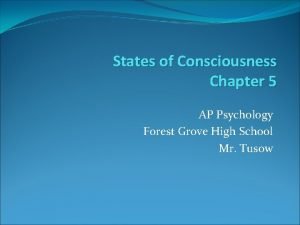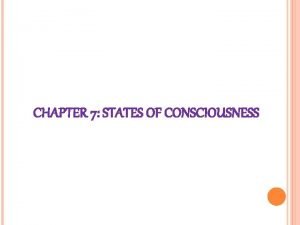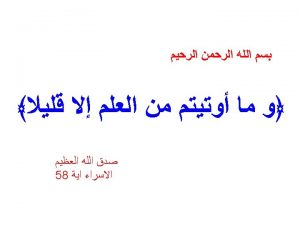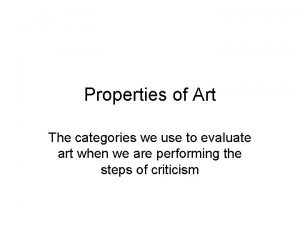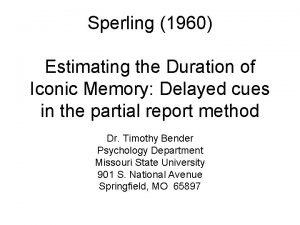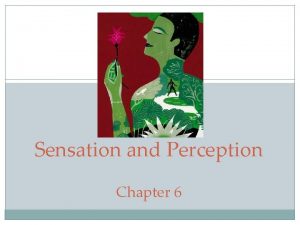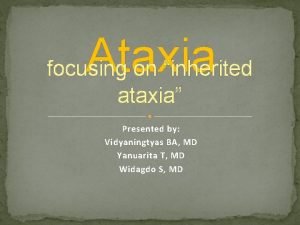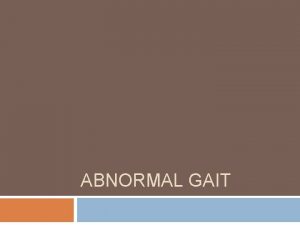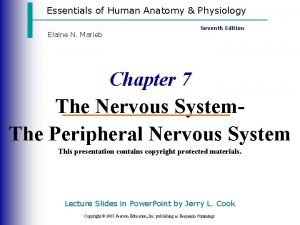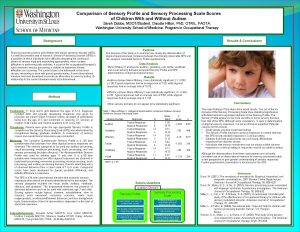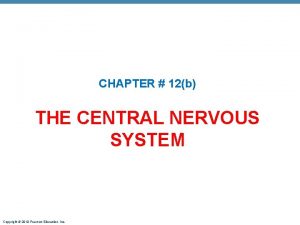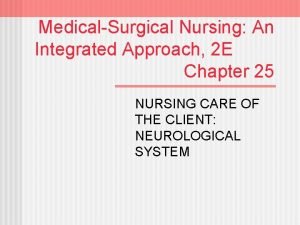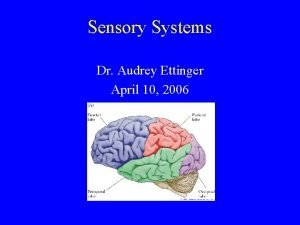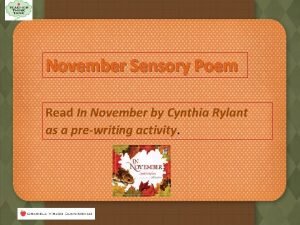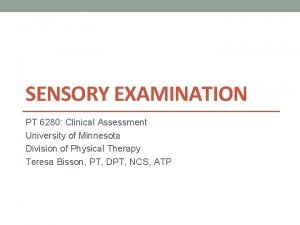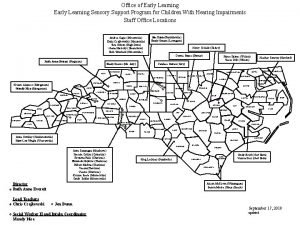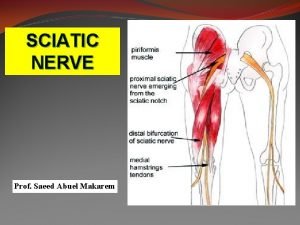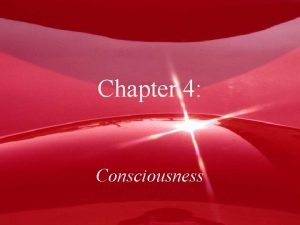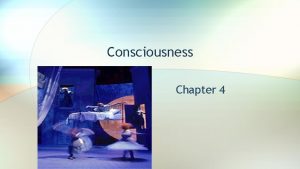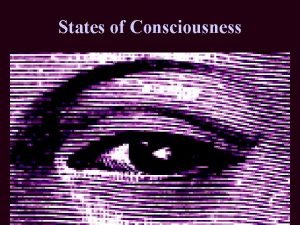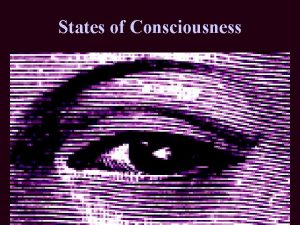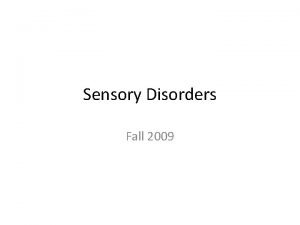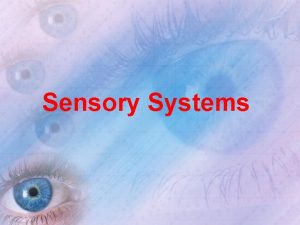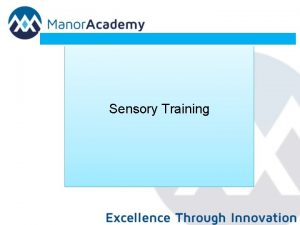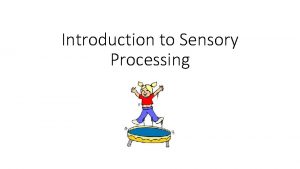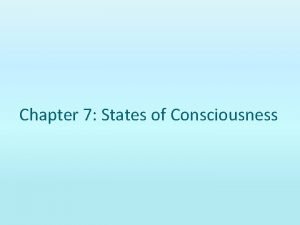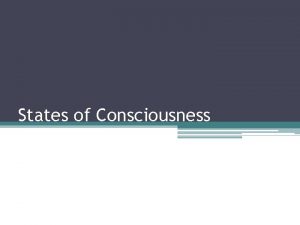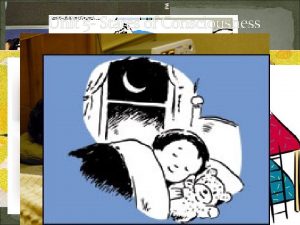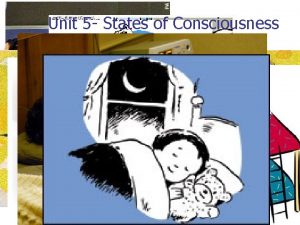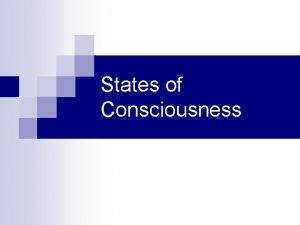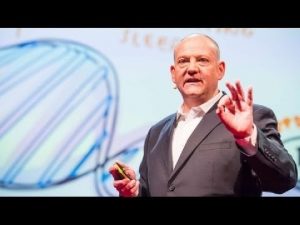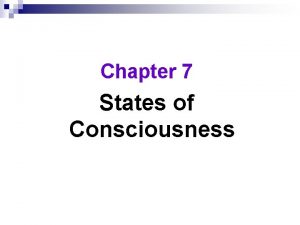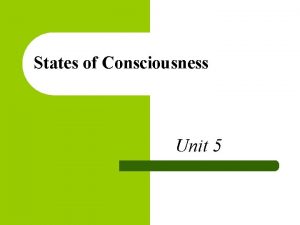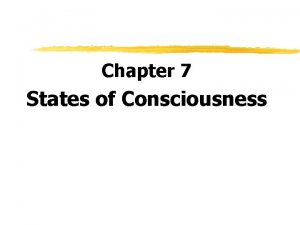STATES OF CONSCIOUSNESS CONSCIOUSNESS Consciousness sensory awareness of






































- Slides: 38

STATES OF CONSCIOUSNESS

CONSCIOUSNESS • Consciousness – sensory awareness of things inside and outside of ourselves • Selective awareness – Focus on a particular stimulus while ignoring other stimulus. – Stimulus That Gets Our Attention - Sudden Changes In Environment - Unusual Items In The Environment - Intense Stimuli (bright colors, loud noises, sharp pains ex. )


CONSCIOUS

PRECONSCIOUS Information you don’t concentrate on or think about unless you are asked about it. (Lunch Yesterday)

(SUB) UNCONSCIOUS information hidden from you under normal circumstances. (Avoidance and Pain not yet realized)

NONCONSCIOUSNESS basic biological functions; breathing, blinking, heartbeat etc.

ALTERED STATES OF CONSCIOUSNESS

DAY DREAMING

DAYDREAMING • Dissociation – The Psych term used to describe this turning away from reality. • It’s an altered state of consciousness. • We can shift from consciousness to this state instantly. • This is a coping mechanism… Helps us escape stress and plan. Every 90 minutes

What are your favorite daydreams? When do you daydream the most during your day? Have you ever been driving and realized that you didn’t know how you got to your destination?

MEDITATION

MEDITATION • Another form of Dissociation. • Some focus on the environment while other focus on your thoughts.

EFFECTS OF MEDITATION • “ 20 minutes a day can reduce stress” – Carnegie Mellon Study • “Student math scores increased by 15% after an investment of time towards meditation at the start of class. ” - University of British Columbia Study • “Meditation offers stronger pain reduction than morphine. ” – Journal of Neuroscience

• First set up the environment. • CLEAR IT OF DISTRACTIONS • Have a seat on the floor or on the edge of a chair where your thighs are above your legs. • Sit there for a few minutes and just gaze ahead at the space. Focus on nothing specific, just be in the space. • Back straight, hands relaxed at your side. MINDFUL MEDITATION STEP ONE Environment

• Focus lightly on your breath. – As it goes in and out naturally – No deep breathes needed, if you find that you are controlling your breath just focus on what that feels like. MINDFUL MEDITATION STEP TWO • Sit there for a few minutes focusing on the breath. Breathing

• As you sit there paying attention to your breathing and your environment thoughts will pop up. • MANY thoughts possibly • When they do recognize that they happened and then gently refocus yourself on your breathing and your environment. MINDFUL MEDITATION STEP THREE Your thoughts


How often did you think? Was it challenging to refocus on the breath?

HYPNOSIS

HYPNOSIS • It is used as a treatment for physical and psychiatric ailments. • Induced by a hypnotherapist's verbal guidance, not a swinging pocket watch! • 95% of people can be hypnotized.



Have you ever woken up moments before your alarm in the morning?

SLEEP

SLEEP JOURNAL Complete it daily After the two weeks you will write a reflection paper IN CLASS relating your own sleep experience with the science of sleep. This collectively will be a 30 point LEVEL 1 assignment. DON’T FORGET TO DO IT!

CIRCADIAN RHYTHMS • The inner biological clock that produces bodily changes in things such as temperature, blood pressure, melatonin, and sleep over a 24 hour period. • This signals sleep in our bodies so that we can… • Revive our tired body • Build resistance to infection • Recover from stress • Increase cell reproduction

• According to our Circadian clock… • When should we start school? • When would you want to compete in a sport?

Stages of Sleep – Repetitious Cycle Stage 1 Stage 2 Stage 3 Stage 4 Rem


STAGE 1 • Lightest stage of sleep • Brief images can flash for some • Pulse starts to slow • Muscles relax and may twitch • Lasts only a few moments You are easily awakened or may be unaware of sleep

STAGE 2 • Short burst of activity called “Spindles” appear on EEG • Progressively sleep gets deeper • Loud noise, touch or light will arouse

STAGE 3 • Deeper Sleep • Do not respond to touch, noises, or light • Heart rate, blood pressure, and body temp starts to drop

STAGE 4 • Deepest level of sleep (Delta Sleep) • Blood pressure, heart rate and body temp as low as they will get. • 90 minutes since we fell asleep • Over the next 40 minutes we will work our way backwards back down the cycle towards REM.

REM • Rapid Eye Movement • Muscles do not wake up but the brain, senses, and biological processes do. • Our eyes start to move back and forth under the eyelids • Still deeply asleep almost paralyzed • Last about 10 minutes and then you go back down the stages of sleep. • IF you are awaken in REM you remember your dreams.



 Class consciousness vs false consciousness
Class consciousness vs false consciousness Consciousness adalah
Consciousness adalah Consciousness includes awareness of
Consciousness includes awareness of Privacy awareness and hipaa privacy training cvs answers
Privacy awareness and hipaa privacy training cvs answers Unit 5 states of consciousness
Unit 5 states of consciousness Chapter 7 states of consciousness
Chapter 7 states of consciousness Consciousness crash course
Consciousness crash course Chapter 7 altered states of consciousness
Chapter 7 altered states of consciousness Chapter 7 altered states of consciousness
Chapter 7 altered states of consciousness Sleep theories ap psychology
Sleep theories ap psychology Lesson quiz 7-1 altered states of consciousness
Lesson quiz 7-1 altered states of consciousness 3 states of consciousness
3 states of consciousness Unit 5 states of consciousness answers
Unit 5 states of consciousness answers Ap psychology states of consciousness
Ap psychology states of consciousness States of consciousness ap psychology
States of consciousness ap psychology Chapter 7 states of consciousness
Chapter 7 states of consciousness How does the constitution guard against tyranny
How does the constitution guard against tyranny Slave states free states
Slave states free states Southern states of america
Southern states of america Tabes dorsalis syphilis
Tabes dorsalis syphilis Properties of arts
Properties of arts Dr andrew sperling
Dr andrew sperling Color constancy example
Color constancy example Sensory ataxia causes
Sensory ataxia causes Waddling gait
Waddling gait Sensory
Sensory Sensory modulation
Sensory modulation Old opie occasionally tries
Old opie occasionally tries Sensory profile scale
Sensory profile scale Sophocles long ago heard it on the aegean explanation
Sophocles long ago heard it on the aegean explanation Anatomy of visual system
Anatomy of visual system Copyright
Copyright Cranial nerves sensory and motor
Cranial nerves sensory and motor Characteristics of sensory neurons
Characteristics of sensory neurons Star diagram sensory analysis
Star diagram sensory analysis Sensory poem generator
Sensory poem generator Le dermatomes
Le dermatomes Early learning sensory support program
Early learning sensory support program Common peroneal nerve injury
Common peroneal nerve injury
